Published
on 5
Mar 2021
|
All rights reserved.
|
|
|
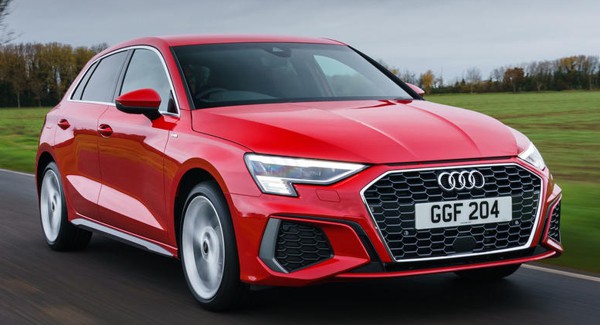
|
|
Expressive
styling hides a good driving manner.
|
|
Since its introduction in
1996, Audi A3 has always been seen as the premium version of Volkswagen
Golf. Built on the same underpinnings, dressed in more tasteful clothes
and finished with an interior more upmarket than even the Volkswagen,
the A3 opened up a new segment called “premium hatchbacks” that would
be followed by Mercedes A-class, BMW 1-Series, Volvo V40, Lexus CT200h
and Infiniti Q30. As the market develops, only the German 3 emerge as
the true contender of the segment, but they need to compete with Golf
and the high-end trims of mainstream hatchbacks as well because
nowadays everybody wants to shift to high-margin products. If the A3
doesn’t feel premium enough, why don’t you choose a Skoda Octavia, Seat
Leon, Ford Focus or Hyundai i30 instead? Therefore, maintaining a
superficial image is crucial to the success of A3.
Obviously, the fourth generation A3 wants to distinguish from the
mainstream by offering more style. However, it is always easier said
than done. A series of brain drain to Korea weakened the creativity of
the entire Volkswagen group design, causing the second and third
generation A3 to adopt a conservative approach. The latest car tries to
be more expressive, most notably from the angular design elements at
the front end that you might easily mistake with the design language of
Lamborghini – although the latter used to be managed by Audi. The
massive hexagonal grille is finished in eye-catching honeycomb
elements, with the number plate floating in the middle. The angular air
vents at either side of the bumpers (both front and rear) are purely
styling elements. In addition to the more pronounced fenders and a slot
deliberately added between the bonnet and fascia, its designer
apparently wants to replicate the sporty aggression of Ur Quattro.
Maybe even the rally stage Sport Quattro. To me, it looks unnecessarily
aggressive for a premium hatchback. I would rather have the understated
elegance of the original A3. The arbitary shape of the headlights is
also failure, although its LED matrix does look cool when turned on.
Styling at the rear end is more successful, especially the 4-door sedan
variant.
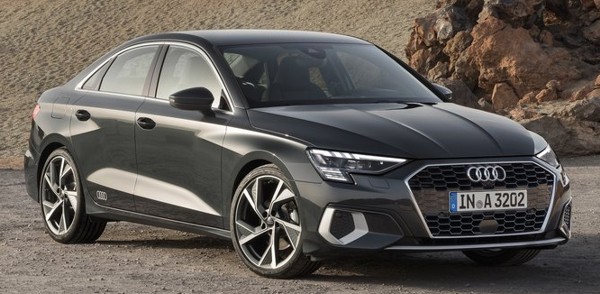
|
|
Sadly,
no engines could give the A3 a performance edge over its Volkswagen
group siblings.
|
|
Overall, the new A3 is clearly a better looking car than the last 2
generations. Despite very similar dimensions – it is 33mm longer, 31mm
wider and 24mm taller for the hatchback, while wheelbase is unchanged –
its body has been polished to be smoother, with rounder corners and a
curvier bonnet. The windscreen looks a tad faster. These changes
undoubtedly help it to lower drag coefficient to a remarkable 0.25
(shutter grille and smooth underbody also help). Meanwhile, the more
pronounced fenders improve proportion considerably, making the sideview
sportier and 3-dimensional, so that it no longer feels flat and bland.
Expressive styling continues in the cabin. Here, it is used to elevate
the avantgarde image as much as to hide the downgraded materials. Yes,
in terms of material richness, the new A3 has taken a step backward,
just like its VW cousin. You might blame the market trend towards
digitalized cabin tech. New age drivers would rather spend time
appreciating the standard 10.25-inch TFT instrument and the 10.1-inch
center touchscreen. They might even pay extra to upgrade to 12.3-inch
instrument so to take advantage of Audi’s “Virtual Cockpit”
functionality, which can display satellite navigation map behind the
floating dials. While all these gadgets look fancy, they are also
costly, so Audi has to cut cost elsewhere. As Ferdinand Piech passed
away, interior designers and engineers are no longer afraid of using
cheaper plastics and sacrificing Dr. Piech’s reputation for achieving
the highest perceived quality. So the use of soft plastics has been
reduced to the dash top and the top of door panels, whereas others have
turned to hard plastics. To draw your attention away from the cheaper
plastics, designers adopt a spaceship-like multi-layer dashboard
design, completed with angular air vents, edgy styling blades finished
in metallic effect and some glossy black panels. It is fine to look,
but perform a “Piech test” with your fingers will find many plastics
hollow or brittle, losing the high-quality perception of the old cars.
Compare with its German rivals, its cabin falls short of Mercedes
A-class in both quality perception and design, while the cabin of BMW
1-Series feels also a tad more solid. It might not be a deal-breaking
disadvantage, but the fact that Audi goes from the top to the bottom of
the trio is disappointing.
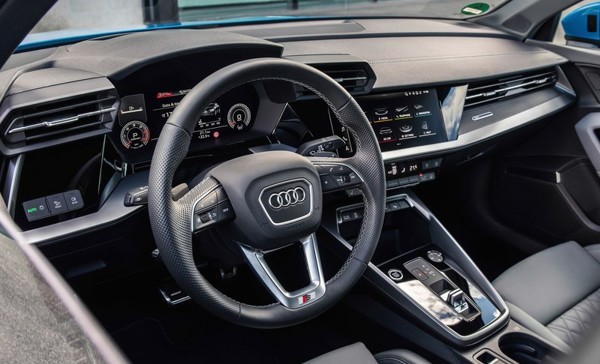
|
|
Material
richness is sacrificed to upgrade digital tech.
|
|
That said, the A3’s cabin is still a nice place to spend time. Like its
Volkswagen stablemate, it is spacious enough for both front and rear
passengers. Rear head room in the sedan version is not quite as good as
the 5-door Sportback (3-door body is no longer available, like all
other MQB evo cars), but legroom is quite generous. The driving
position is faultless. The multi-function steering wheel is fabulous.
The front seats are comfortable yet they use materials recycled from
plastic bottles. The digital instrument and touchscreen display crisped
and attractive images. The MMI infotainment system is far more
intuitive to use than the VW version. Moreover, while Golf has moved
virtually all controls to the touchscreen, Audi keeps a row of physical
buttons under the touchscreen for controlling air-con etc. While the
Golf uses a troublesome touch-sensitive slider to adjust audio volume,
in the A3 you use a roller switch on steering wheel to do the same
function. In short, the ergonomics problems troubling VW are mostly
avoided in the Audi.
As a premium car, safety is also well taken care. The A3 offers
standard automatic emergency braking, lane-departure warning and
collision avoidance steering assist.
In the mechanical aspect, there is not much to surprise. The A3 used to
catch the attention of automotive journalists because it always made
debut before the equivalent Golf, thus previewed the new generation
Volkswagen group platform. This is no longer the case now. As we have
already seen the new Golf, and we all know the underpinning MQB
platform is merely updated to accommodate new technologies like 48V
mild-hybrid system, none of the mechanicals aspect in the new A3 is new
to us.
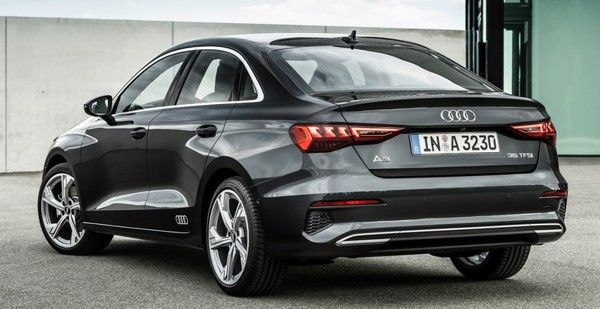
|
|
Sedan
is better proportioned than the Sportback.
|
|
As before, MQB is a flexible platform, accommodating petrol, diesel,
mild-hybrid and plug-in hybrid powertrains. In the latter case, all
variants in the group share the same hardware: a 1.4-liter TSI engine
pairs with an electric motor housed in the 6-speed dual-clutch gearbox
and a 13kWh lithium battery mounted under the rear seat. It offers a
combined output of 204hp or 245hp, depending on models, but the chief
difference is the availability of battery power rather than the engine
and motor themselves. Frankly, the resultant A3 TFSIe is designed to
deceive CO2 fleet emission standards
rather than benefiting the drivers, because you get an electric range
of only 65km, and most likely even less in the real world. The extra
weight of 240kg is also an enemy to driving fun.
Comparatively, the 1.5TSI variant is more pleasing. Smooth, gusty
enough, works imperceptibly with mild-hybrid boost yet returns good
fuel economy. Volkswagen group’s 7-speed dual-clutch gearbox shifts
quickly and unobtrusively. Meanwhile, the updated 2.0TDI diesel engine
is flexible and refined, a pity that it is falling out of market
favour.
Sadly, no engines could give the A3 a performance edge over its
Volkswagen group siblings, as fleet emission limit has it handicapped.
If you want a quicker A3, you will need to upgrade to S3, but then
again, it is no faster than Golf R either.
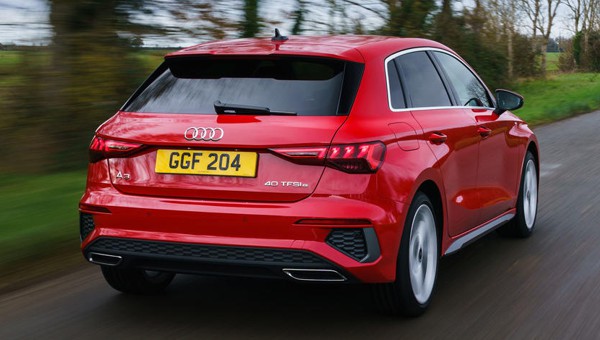
|
|
It
needs a stronger, more distinctive character to match its expressive
styling.
|
|
As before, the A3 models with less than 150hp have to settle with a
simple torsion beam rear axle. Fortunately, the best selling 1.5TSI
rides on multi-link setup. S line trim gets stiffer and 15mm lower
suspension setting, while adaptive dampers are optional.
With multi-link and S line passive suspensions, the A3 strikes a good
balance between handling and ride. Low-speed ride on poorer surfaces
might catch it out a little, but otherwise it is composed and
compliant, eager to steer with its direct steering, stable and quiet in
high-speed cruising. It offers plenty of grip and exhibits good body
control in corners. All things very similar to the Golf.
However, there is not a single area the Audi impresses. While the
steering is quick and precise, it is rather short of feel. The ride is
not as supple as Mercedes A-class. The handling not as sporty as BMW
1-Series. The chassis balance not as interactive as Ford Focus. In the
end, the driving experience leaves you admired but not impressed. This
car is not short of talents, but it needs a stronger, more distinctive
character to match its expressive styling.
|
Verdict:     |
Published
on 16
Mar 2021
|
All rights reserved.
|
|
Audi S3
|
|
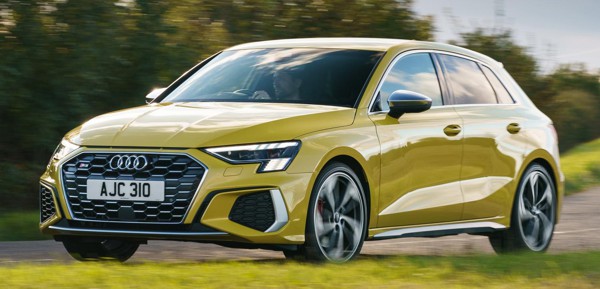
|
|
Facing
more competition, S3 no longer enjoys a superior image, even though it
has improved considerably in handling...
|
|
Though being famous for
“Quattro”, Audi never intended to make the S3 a match for Lancia Delta
Integrale, Subaru Impreza or Mitsubishi Evo. Instead, it was designed
to be the first ever “premium performance hatchback” on the market,
preceding BMW 130i by 6 years and Mercedes A45 by 14 years. While
performance isn’t especially strong, it provides an elegant look, a
quality interior and all-weather drivability lacking in other hot
hatches – only its stablemate VW Golf R32 could match perhaps. However,
as the new segment develops, now its German rivals have much sharper
weapons to break its dominant – the new BMW M135i and Mercedes-AMG A35,
both possess more than 300 horsepower and all-wheel drive capability.
You may count also the new Golf R, which has elevated to a higher price
point accompanied with upgraded technical specifications. The Audi has
never been facing competition so stiff.
As always, the styling changes from lesser A3s are very subtle, so you
need to spot the metallic finish on the front splitter and door
mirrors, the 3 slots located just under the bonnet or the quad-exhaust
to make sure it is an S3. Like the A3, it is not a particularly
memorable shape, and its angular features might displease those
preferring the understated beautify of the original S3. The interior is
equally disappointing, blame to the complicated dashboard design and
the increase use of cheaper plastics. Now it falls behind its German
rivals in quality perception. What used to be its strength is now its
weakness.
The latest evolution of EA888 engine keeps the 2-liter displacement
unchanged, predictably, but there is a higher injection pressure and
the variable “Valvelift” system has changed from the exhaust side to
intake side. The calibration of engine and 7-speed S tronic gearbox
aims to cut emission, but output rating remains the same as before,
i.e. 310 horsepower and 295 lbft of torque. Ditto the 0-60 mph time of
4.6 seconds, about the same as M135i and A35. That's faster than any
mainstream hot hatches, thanks to the traction of Quattro.
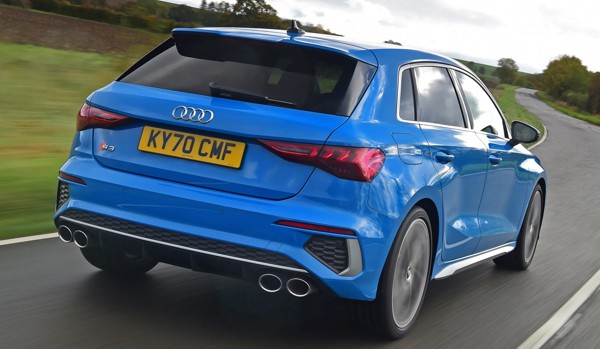
|
|
The
steering finally gets some feel, not the artificial weight of the old
car. Understeer is no longer its default behaviour.
|
|
On the road, this powertrain is good enough, if lacking a bit of
character. It hesitates a little below 2000 rpm. Once overcome turbo
lag, it pulls linearly towards redline with satisfying response and
smoothness. What a pity its soundtrack is rather sleepy, while the
exhaust pops and crackles on overrun are too subtle. If you want better
sound, Audi will point you to the 5-cylinder RS3 to be launched soon,
but you might be better served by its German rivals and some mainstream
hot hatches as well. Likewise, the S tronic gearbox is smooth in normal
driving, but in full-bore acceleration it doesn’t responds quickly
enough, while the shift paddles lack tactile feel. In short, the
powertrain combo is effective rather than engaging.
The S3 employs the latest, 6th generation Haldex coupler for its
Quattro system. It is said to be able to send 100 percent torque to the
rear axle in extreme conditions, but frankly, you need really extreme
conditions to realize that claim, such as when the front wheels riding
on ice. In the real world, it never feels like sending more than half
its power to the rear. In fact, the biggest improvement of Haldex 6 is
that it can fully decouple the rear axle in normal driving in order to
cut fuel consumption (thanks to CO2 limit
again). This is made possible by using higher pressure hydraulic to
activate the multiplate clutch, so that the coupling is more
responsive. Unlike the new Golf R, the S3 relies on brake-based torque
vectoring rather than multiplate clutches to direct power between rear
wheels, so we don’t expect it able to play drift like the new Golf R or
AMG A45 S, let alone the rear-drive BMW M2 Competition.
Compared with lesser A3s, the S3 rides on stiffer and 15mm lower
suspension. Adaptive dampers are optional, as are 19-inch wheels and
235/35 tires.
On the road, those bigger wheels and thinner tires provide strong grip
and traction, but the downside is a stiff ride on B-roads, making the
S3 a less forgiving companion than either its BMW or AMG rivals.
However, the Audi does surprises with its new found agility. Its
turn-in is sharper than ever. The steering finally gets some feel, not
the artificial weight of the old car. Understeer is no longer its
default behaviour. In fact, it is remarkably neutral. If the road is
wet, you may push it into a little oversteer. On dry roads, it is just
neutral, keeps gripping hard, controlling its body movement tightly and
turning into the guided path. As the rear-end is more planted, it is
not as entertaining as some of the best front-drive hot hatches, nor
the 4WD Evo of the past, the new GR Yaris or the AMG A45 S in drift
mode. A quick A-to-B car undoubtedly, but like its powertrain, its
chassis is effective rather than engaging.
That is quite sad, because the new S3 has a better chassis than ever.
It just proves that the competition has moved on a lot in many areas,
while Audi has taken a backward step in styling and build quality. At
this price, there are a lot of better choices.
|
Verdict:    |
Published
on 2
Nov 2021
|
All rights reserved.
|
|
Audi RS3
|
|
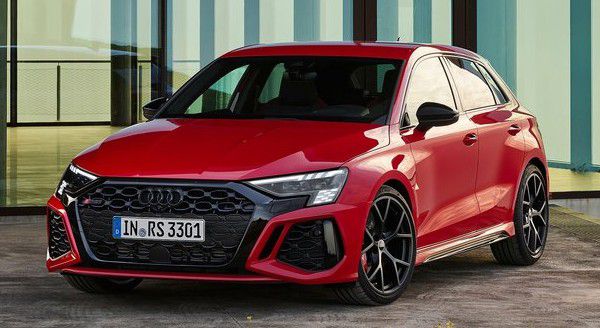
|
|
New
4WD system gives RS3 a new lease of life.
|
|
Sitting above S3, the RS3
is a super-hot hatch, or a super compact sport saloon if you opt for
4-door body. Pricing starts at £51,000, but after adding adaptive
dampers and other desirable options it can easily cost double the price
of a Honda Civic Type R. That’s more expensive than even its arch-rival
Mercedes-AMG A45 S. In return, the RS3 gives you immense performance
and a very aggressive look, if not a tasteful one.
Since its birth a decade ago, Audi RS3 has been using the firm's unique
5-cylinder engine with 2.5 liters displacement. It produced 340hp in
the beginning, then rose to 367hp and 400hp. The latest version keeps
the 400hp output, but it is available slightly earlier than before,
from 5600 all the way to 7000 rpm. Maximum torque is lifted by 15 lbft
to 369 lbft, thanks to an increased turbo boost pressure, and it is
available across a wider band (2250-5600 rpm) as well. Although it
makes 21 horsepower less than AMG A45 or CLA45 S, the RS3's torque
delivery is far broader, thanks to an extra cylinder and 500 c.c.
Perhaps this is why Audi claims it takes just 3.7 seconds to sprint
from 0-60 mph, a tenth quicker than the AMG. It has an advantage in top
speed, too, as you have the choice to lift its speed limit from 155 mph
to 174 mph or even 180 mph if you opt for the RS Dynamic pack and
ceramic brakes. The AMG? No more than 168 mph.

|
|
Saloon
body is more beautiful yet carries only an extra 5 kg.
|
|
In the chassis side, there are upgrades to suspension (10mm lower than
the S3, stiffer, stronger, more negative camber etc.), larger brakes
and electronic control systems. However, the biggest news is abandoning
the long-serving Haldex-clutch-based Quattro system for a new RS Torque
Splitter supplied by Magna. In fact, the same hardware was first used
in VW Golf R, and a similar one used even earlier on its AMG
arch-rivals. Its design is pretty simple: the prop-shaft drives the
rear axle through a bezel gear. There are 2 multi-plate clutches
attached the ends of the rear axle, each couples to a rear wheel. When
both clutches open, the RS3 runs in FWD mode to save fuel. When both
fully engage, 50 percent torque goes to the rear axle. In corner where
you need to tame understeer or even introduce some oversteer, the
inside clutch opens and the outside clutch engages, so more torque goes
to the outside rear wheel. Therefore, by altering the degree of clutch
engagement, you can control the balance of the car.
Thanks to the new torque splitting device, the new RS3 can introduce a
drift mode called “RS Torque Rear” to thrill its driver. However,
unlike the last Ford Focus RS, the Magna device can never deliver more
than 50 percent torque to the rear axle (unless the front wheels are
running on slippery surfaces while the rears are not). That said, as
proved by AMG and Golf R, the ability of directing all that 50 percent
torque to the outside rear wheel is already very useful and fun enough.
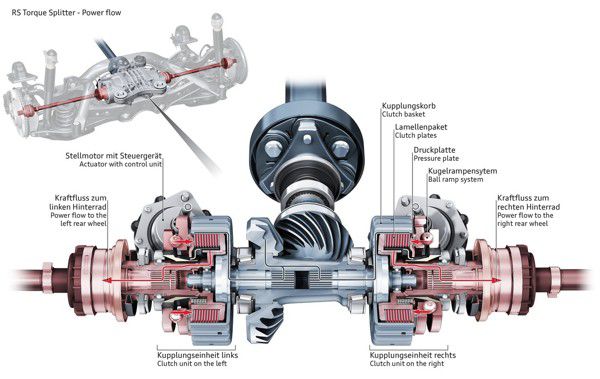
|
|
Torque
vectoring is now possible at the rear axle, though it receives no more
than 50% torque from the engine.
|
|
On the road, 2 things are immediately noticeable. Firstly, it rides
well. All previous RS3 used to be stiff and harsh on less than perfect
surfaces. The new car might not be as absorbent as a Ford Focus ST or
Civic Type R at lower speeds, but when you attack fast B-roads it shows
perfect damping and remarkable composure. It doesn’t crash on nasty
bumps. Sharp bumps can’t unsettle its balance and composure. It just
glides over everything you throw at it. As a result, you can drive
harder and enjoy the car more of the time, on a variety of surfaces.
With adaptive dampers set in Comfort mode, it even makes a Golf R or
AMG A45 S feel like the old RS3. In short, the ride control is
transformed. This is perhaps the biggest improvement of the new car.
Another is better balance. RS3 of the past gave us just one word:
understeer. While the new car is not totally transformed in this
respect, it is certainly more neutral. You still feel the weight of the
5-cylinder motor hanging at its nose, but given the 265/30YR19 front
rubbers – 20mm wider than those at the rear – the new car offers more
front-end bite to sharpen turn-in and keep the nose pointed. It doesn’t
steer as sharply as AMG, but it feels more natural. The steering offers
enough feedback and linearity in response. In a fast, long curve, you
can feel power shuttles to the rear axle and outside rear wheel to trim
understeer. Meanwhile, the stiffer suspension keeps body roll, pitch
and dive in check. Not overly hardcore, just work in a linear and
natural way.
 |
|
To
access oversteer, you need to learn to trust on it.
|
|
In a tighter bend, despite the beefy front tires, the RS3 will run into
understeer. If you have learned to trust its new 4WD system, be brutal
on throttle will trigger the power shift rearward and to the outside
rear wheel, then the car will rotate, swing its nose to the inside of
the corner. Problem is, this shift from under to over-steer could feel
unnatural or even catch you a surprise. It takes trust rather than
basic instinct to keep pushing it. Should you unwind the steering and
back off abruptly – as most drivers do to tame oversteer – the power
flow will stop immediately and the car will revert to understeer. This
means, while powerslide is achievable on the RS3 for the first time, it
is not intuitive to access.
What about the “RS Torque Steer” mode? The RS3 is not a rear-drive BMW
M2. You absolutely need a track or an empty car park to play drift,
which is pointless to a hot hatch. Even on a track, the drift is never
going to be as smooth and enjoyable as you can have on an M2
Competition or CS.
What about the rest of the car? The 5-pot engine feels a little dated
by now, exhibiting too much turbo lag (it needs 2500-3000 rpm to take
off) yet the exhaust is made muted in this incarnation. The 7-speed
dual-clutch gearbox downshifts too slowly, failing to live up to the
expectation for this performance class. The optional ceramic brakes
help improving ride but the pedal response is non-linear.
Overall speaking, the new RS3 is faster, more comfortable and
better-balanced than ever, but it is not as enjoyable to drive to the
limit due to the limitation of its 4WD system and the laggy powertrain.
The AMG A45 S is noisier and feels more exciting. An M2 Competition or
CS is more fun. Ditto a Civic Type R that costs half the money.
|
Verdict:     |
Published
on 11
May 2024
|
All rights reserved.
|
|
Audi S3
(2024)
|
|

|
|
New
variable torque split device transforms the S3.
|
|
The wider A3 family has
received a facelift this year, but our interest focuses on the hot
variant S3, because it gets some real performance lift. First of all,
the EA888 engine gains 23 horsepower and 15 pound-foot of extra torque
to 333 hp and 310 lbft, finally more than its Volkswagen Golf R
sibling. Apart from 0-60 mph is cut by a tenth to 4.5 seconds, in the
real world you will notice slightly improved response when floor down
the throttle, because the turbo is now pre-loaded with exhaust gas
during off-boost. While Honda still makes the sweetest 2-liter turbo
engine, the EA888 is not far off, combining strong power and linear
delivery.
Secondly, the 7-speed S Tronic dual-clutch gearbox gets stronger
clutches such that shift time is reduced by half according to Audi,
although in reality this is harder to detect.
Thirdly, the front suspensions get new lower control arms to increase
negative camber. This enhances front-end bite and steering response in
corner. There is also retuned dampers and stiffer bushings to match.
Besides, larger front brakes (357mm) and new calipers improve stopping
performance.
Lastly and also the most importantly, the S3’s Quattro system has its
usual Haldex coupler replaced with the variable torque split device
(also by Haldex) already used on the RS3 and Golf R. It employs 2
multi-plate clutches to engage the left and right rear wheels
independently, can theoretically deliver up to 50 percent torque to the
rear and up to all of which to a particular rear wheel. In other words,
it does the work of torque vectoring and active differential. Besides,
the S3’s control system gets an additional mode called Dynamic Plus,
which favours maximum rear axle delivery and torque vectoring to the
outside rear wheel.
As a result, the S3 feels more agile than ever. In Dynamic Plus mode,
understeer is suppressed so well that the car just points towards
wherever you steer. It is still difficult to oversteer on purpose,
because only up to 50 percent torque can be sent to the rear unless the
front wheels are slipping, but the new found neutrality of its handling
manner is welcomed, certainly more delicious to keen drivers than the
default understeer of the outgoing car. What a pity the steering
remains quite numb to feel what’s going on the front tires
For driving thrills, the S3 still trails the likes of Honda Type R or
the late Renaultsport Megane, but it edges closer to a perfect
all-rounder, because when you are not in mood to attack, you can enjoy
the refinement brought by a proper premium car. It can be quiet and
smooth in long journeys. Pretty economical to run, too. It will take
you to shop and your children to school. Visibility is not blocked by a
big rear wing. Yes, £47,000 is a lot of money for a hot hatch,
but Mercedes and BMW charge about the same for their equivalents.
|
Verdict:     |
|